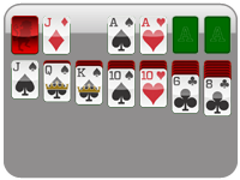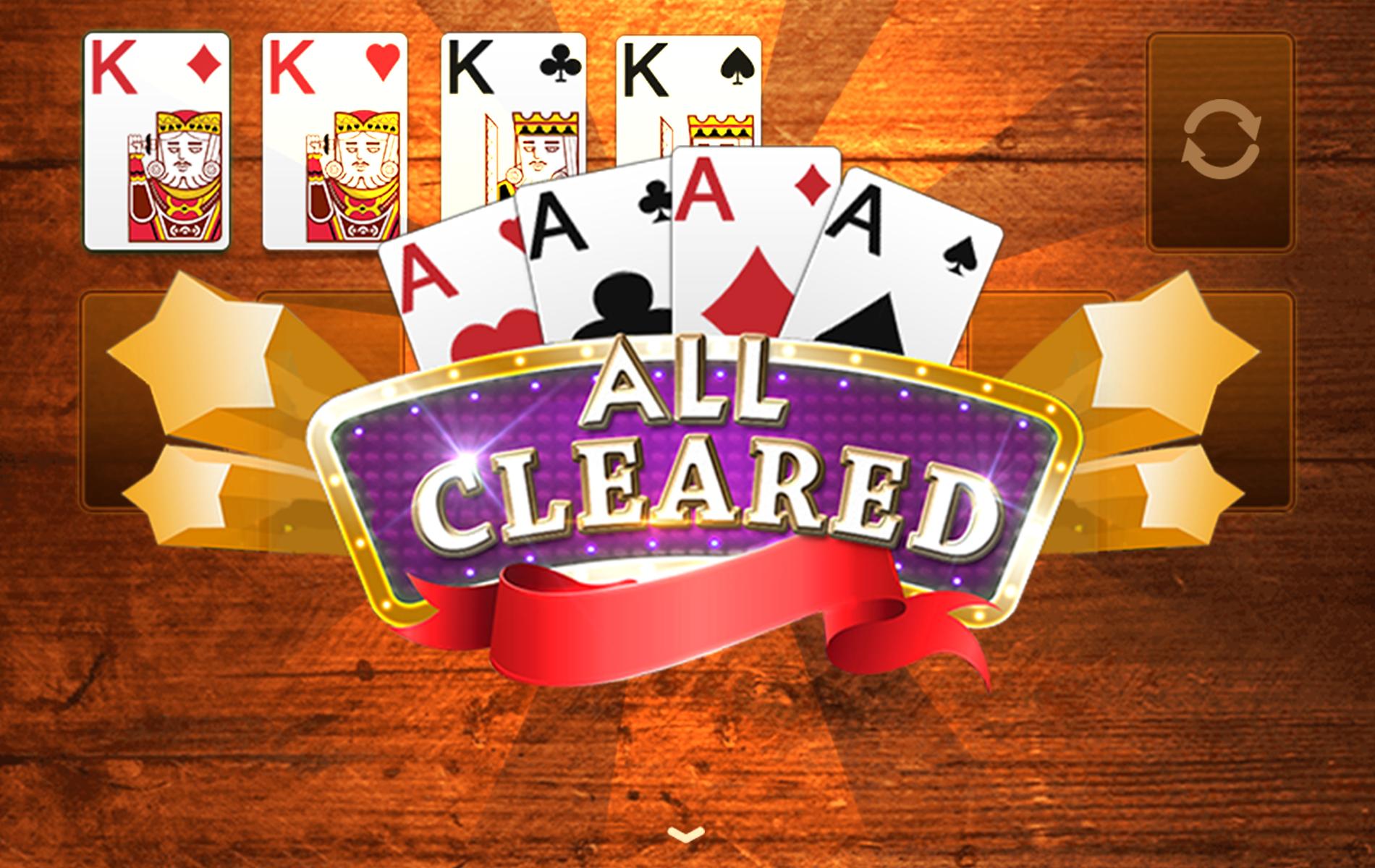Solitaire Time
Solitaire is an exciting way to pass the time - anywhere, any time. Whether you are at home on lazy day, at the office taking a break, or outside with your laptop soaking in the sun, spice up your day with a game of solitaire. Escape a mundane task with a quick win that will rejuvenate your spirit! 247 Games offers a full lineup of seasonal Solitaire games. Click on any of the games below to play directly in your browser. All of our Solitaire games are 100% free, all day, every day! Freecell is a great game because it is winable almost 100% of the time, which it the highest percentage for any random deal in a card game. 247 Freecell offers 6 other games though to help you enjoy this classic card game without you getting bored! You can now choose additional Solitaire games! Choose 'Select Game' from the Solitaire menu. Increased the empty space between the menu/left side and the playspace area - The menu will no longer activate while you are dragging a card - Fixed a bug where if you dealt a new game during the win animation your new game would be cleared accidentally.
Spider Solitaire Time gives you a couple of minutes to distract from intensive brain activity and chill. Restart your brain by playing classics and assemble decks from aces to kings. Select one of three game modes and feel free to play with cards. Don’t do it too long as the time is limited.
Game Statistics
- Rating 4.67
- Rated 3
- Played 9,641

Tags

Embed Game

Share
Start playing unlimited online games of solitaire for free. No download or email registration required, meaning you can start playing now. Our game is the fastest loading version on the internet, and is mobile-friendly.
Play over 500 versions of solitaire - Play Klondike Turn 1, Klondike Turn 3, Spider, Free Cell, Pyramid, and Golf , among many other versions.
Undo moves - The chances of winning are between 80 and 90%. However, even if you have a winnable game, if you make one wrong move, it may be the end of your game. If you're stuck, you can undo as many moves as you’d like to get yourself back in the game and win!
Change difficulty levels - You can play with turn 1 and turn 3 options. Turn 1 is when 1 card is drawn from the stockpile at a time and is an easier version. Turn 3 is when three cards are moved from the stockpile at time, and is harder because you can only play every third card.
Track your moves and time - If you're competitive, you’ll want to track how many moves it takes to win a game, how long it takes, and how many times you pass through the deck. You then challenge yourself to beat your record times and number of moves. Practice makes perfect!
Create a free account - If you’d like, you can register an account to save a game and pick up where you left off on any device. We’ll even track all the games you’ve played, including your time to completion and total number of moves. You’ll can see how you get better over time.
Play the game of the day - Everyday, we introduce a new winnable game. See how you perform compared to other players.
Play on your mobile phone or tablet - Our game works perfectly on any size phone or tablet device, both in vertical and horizontal orientations.
Enjoy a clean design and animations - We’ve designed our playing cards to be classic and clean, so they are easy to read as you sequence cards, and our animations keep you engaged. You can also customize designs and playing cards.
If you like classic games, try our other sites: FreeCell Challenge, Spider Solitaire Challenge, Mahjong Challenge, Minesweeper Challenge, and Unscrambled Words.
We also created Solitaire Brain so you can learn some fun facts while you play.
Solitaire rules and how to play
Game setup: After a 52-card deck is shuffled you’ll begin to set up the tableau by distributing the cards into seven columns face down, with each new card being placed into the next column.
The tableau increases in size from left to right, with the left-most pile containing one card and the right-most containing seven. As an example, this means the first seven cards will create the seven columns of the Tableau. The eighth card distributed will go into the second column, since the first column already has its one and only card.
After the piles are complete, they should be cascaded downwards such that they form a “reverse staircase” form towards the right. Ultimately, you will have seven piles, with the first pilie containing one card, the second pile containing two cards, the third pile containing three cards etc. Only the last card in each of the Tableau columns is flipped over face up so you can see it’s suit, color and value. In our game, this is automatically done for you!
All leftover cards after the foundations are created become the “Stock,” where you can turn over the first card.
Goal: To win, you need to arrange all the cards into the four empty Foundations piles by suit color and in numerical order, starting from Ace all the way to King.
Tableau: This is the area where you have seven columns, with the first column containing one card and each sequential column containing one more additional card. The last card of every pile is turned over face up.
Stockpile: This is where you can draw the remaining cards, which can then be played in the game. If not used, the cards are put into a waste pile. Once all cards are turned over, the remaining cards that have not been moved to either the tableau or foundation can then be redrawn from the stockpile in the same order.
Playing the game:
- Face up cards in the tableau or stockpile can be moved on top of another face up card in the tableau of an opposite color that is one rank higher, forming a sequence of cards.
- Groups or stacks of sequenced cards in the tableau can also be moved together on top of a card of the opposite color and higher rank.
- If a tableau column has only face-down cards remaining, the last card is flipped over and can be played.
- To start a foundation pile, an Ace must be played. Once a foundation pile is started, only cards of that suit can be placed in that specific pile.

- As cards are surfaced from the stockpile or tableau, and there are no other cards on top of them, they may be moved to a foundation pile if they can be placed in the right order.
- If a tableau column is empty, you may move a King, and only a King, to that column.
- Win by moving all the cards to the Foundation piles in the right order.
History of Solitaire
One-player card games are called by some form of the word ‘solitaire’ in some countries (US, Spain, Italy, etc), ‘patience‘ in others (UK, France, etc) or ‘kabale’ in others (Scandinavia, eastern Europe), but both ‘solitaire’ and ‘patience’ are increasingly common worldwide.
Solitaire Time 247
The oldest of these, ‘kabale,’ implying something secret or occultic, suggests that the idea of laying out cards in a pattern or ‘tableau’ had its origins in fortune-telling (cartomancy), which became popular in the mid-1700s in Europe. Possibly its original purpose was light-heartedly to divine the success of an undertaking or a vow. If the game ‘succeeds’ or ‘comes out’, the answer is favorable, otherwise not. In France card solitaire is still called ‘réussite’, meaning ‘success’.
In a German games book of 1798 ‘patiencespiel’ appears as a contest between two players, while bystanders and presumably the players themselves wager on the outcome. Single and double-deck versions are described, and seem to be much like one later recorded in English books as Grandfather's Patience. Some references suggest either Sweden or Russia as the place of origin.
Books of solitaire games first appeared in the early 1800s in Russia and Sweden, and soon after in France and the UK. Most seem to have been written by women. A Livre des patiences par Mme de F**** (possibly the Marquise de Fortia), for example, was into its third edition by 1842 and was soon translated into English. Many of the games described have titles commemorating the Emperor Napoleon, such as Napoleon at St Helena, Napoleon’s Square, etc, probably based on the entirely mistaken assumption that Napoleon amused himself by playing solitaire in exile, for which there is no evidence. In fact he most often played games called Pique and Whist.
Dickens portrays a character playing patience in Great Expectations. This was published in 1861, the year in which Queen Victoria’s husband, Albert, who was himself a keen player, died. The first American collection was Patience: A series of thirty games with cards, by Ednah Cheney (1870). Around that time, a British Noble women named Lady Adelaide Cadogan published Illustrated Games of Patience. The last decades of that century were the heyday of patience games, the largest collections being compiled by the prolific Mary Whitmore Jones.
From then on solitaire games settled down into a fairly nondescript existence. From popular literature, print media and movies it soon becomes clear that most people with any interest in card games knew only two or three of the most popular types, such as Klondike and Spider, and whichever one they played they called solitaire without being aware that any others existed. Such further collections that appeared in print were largely rehashes of classic titles, with little or no acknowledgement given to previous authors or inventors. Nothing of any value appeared until 1950 when Albert Morehead and Geoffrey Mott-Smith published their Complete Book of Patience. These authors had clearly studied all the literature, tidied up conflicting rules, and for the first time ever decided to classify games and arrange them in some sort of logical progression. Thus, if you found that you liked a particular game you could then explore others of similar type, and ignore the ones that failed to appeal to you. Throughout most of its history solitaire has been regarded as a pastime for invalids rather than the physically active, and for women rather than men, though it must have been much played by prisoners-of-war who were fortunate enough to have some recreational time on their hands.
All that began to change in 1990 with the advent of Microsoft’s first digital solitaire collection, originally intended to teach people how to use a computer mouse. This same phenomenon caused FreeCell and Spider to both rise in popularity among the general population, as they appeared as free games in later editions of Windows. According to a news item released in May 2020 over half-a-billion players in the past decade alone have played the game. It is now a global phenomenon.
Note that many games from the late 1800s have you start by arranging the cards in a pretty but complicated pattern taking up a lot of space. These gradually went out of fashion over the last 160 years as tables got smaller and players wanted to spend more time playing than dealing. They could be easily reproduced on a desktop monitor but would not be suitable for play on the small screen of a cellphone. In any case, strictly symmetrical, straight up-and-down layouts are more in keeping with the digital zeitgeist.
Citations and further reading:

- Das neue Königliche L’Hombre-Spiel, 1798.
- A collection of the card layouts usually known as Grand-patiences, 1826.
- Mary Whitmore Jones, Games of Patience for One or More Players, 1890 - 1910.
- Albert Hodges Morehead and Geoffrey Mott-Smith, The Complete Book of Patience, 1971.
- David Parlet, Solitaire: Aces Up and 399 Other Card Games, 1978.
Www.solitairetime.com
News and updates
Play Free Solitaire Online
- 12/16/20 - We've rebuilt our Freecell and Spider games so they now have the same great features as our Klondike game. On those games, you can now play the game of the day and change card desgins. Check them out!
- 12/29/2020 - We added a new tile matching game, Mahjong! If you don't know how to play, there is a guide to instruct you below the game!
- 1/12/2021 - We introduced Hearts, a trick-taking card game, to our platform. While normally played with other people, you can play against the computer. Keeping track of cards and anticipating moves is critical to winning this game.
- 1/20/2021 - Now when you play on mobile, the cards will appear bigger. We hope this will further imporve gameplay and usability for mobile users.